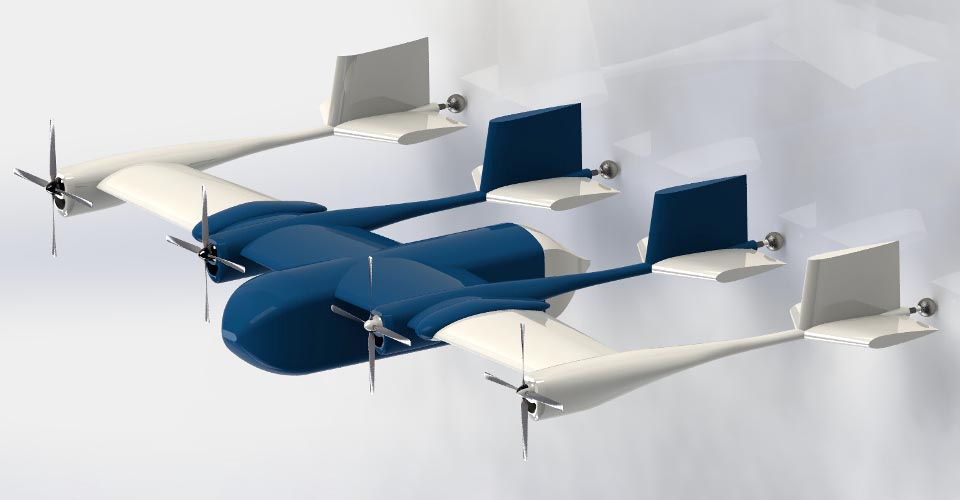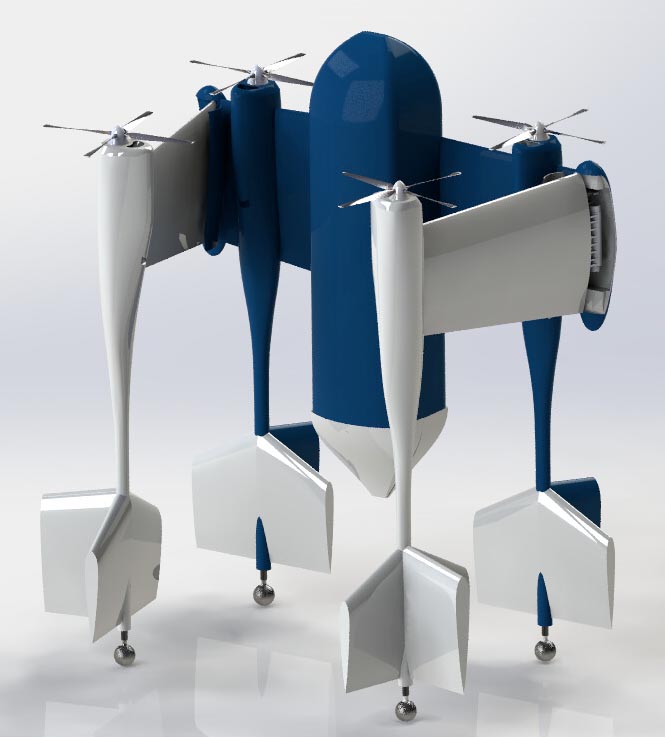
Aerospace engineering students designed a combination aircraft that can achieve vertical and horizontal flight, named Albatross after the large seabird, which has smooth and flexible flight capabilities. Here, Albatross flies like a plane. IMAGE: STUDENT DESIGN TEAM
Aerospace engineering design team places second in vertical flight competition
Named "Albatross," the winning aircraft launches like a helicopter, flies like a plane
9/23/2021
By Mariah Chuprinski
UNIVERSITY PARK, Pa. — A Penn State undergraduate design team took second place at the Vertical Flight Society’s 38th Annual Student Design Competition, edging out other competitors with their autonomous vertical takeoff and landing aircraft named “Albatross.”
Sponsored by Boeing, the competition tasked the students with developing an unmanned aircraft that could quickly deliver supplies in a 31-mile radius with a 110-pound payload and travel to a logistics center 124 miles away at a slower pace. The Vertical Flight Society called for these parameters in order to simulate delivery of medical supplies and food quickly to precise locations during a future pandemic or natural disaster.
The fourth-year students participated in the competition as part of their senior capstone projects in AERSP 402: Helicopter Design, a subset of the department’s aircraft design capstone course.
“Our proposal was a unique design, a combination aircraft that could achieve vertical and horizontal flight,” said Jonathan Detwiler, a 2021 aerospace engineering graduate and one of the student participants. “As Albatross launches, its wings are folded in into a square configuration. It launches up vertically like a helicopter, unfurls its wings and flies forward, with wings extended, like a plane.”
Adding the wings to the concept was important to conserve fuel, Detwiler said.
“A helicopter is not fuel efficient when flying forward because it uses rotors, which use up a lot of energy,” he said. “If you add wings, the aircraft becomes more energy efficient in forward flight. However, the rotors are necessary to achieve vertical takeoff.”
Just like what is required in a professional engineering call for proposals, the students submitted a full report to the Vertical Flight Society detailing their design, including an executive summary, a technical report and a safety analysis. The technical report detailed the mathematics and aerodynamic proof-of-concept, and the safety analysis proved the aircraft could land safely even if a wing or rotor malfunctioned in flight.
“Our students rose to meet a very tough challenge,” said Edward Smith, professor of aerospace engineering and one of the team’s advisers. “Not only were they working as a cohesive team and learning new technologies throughout the year, they also had a particularly tough rotorcraft aircraft design mission to accomplish.”
The students named their design Albatross because of the large seabird’s expert flight capabilities.
“The albatross has large wings that it unfolds to fly, and can soar for long periods, just like our aircraft can,” said Detwiler, who now works as a systems engineer for Northrop Grumman.
The 2020-21 undergraduate student design team was comprised of eight fourth-year aerospace engineering students, including May 2021 graduates Sean Berger, Jonathan Detwiler, Joshua Forrest, Zackary Long and Daniel Szallai; August 2021 graduate Ryan Casterline; and JR Sciple and Xinpeng Zhao, who will graduate this December.
The group won $1200 for their second-place award, which was distributed equally to the students.
“We are very proud of the team for their combination of professionalism, dedication and technical ability,” Smith said. “It’s no surprise that their work was recognized by the competition judges!”




